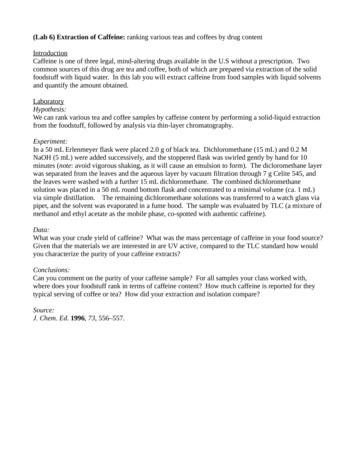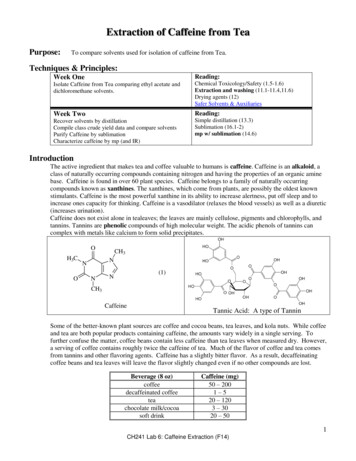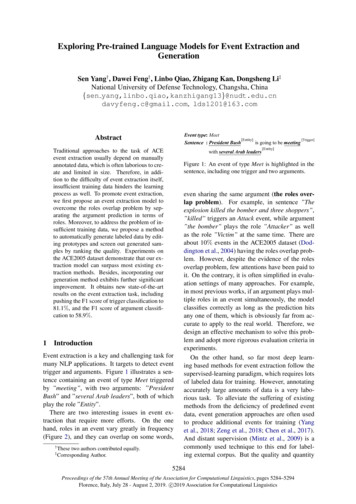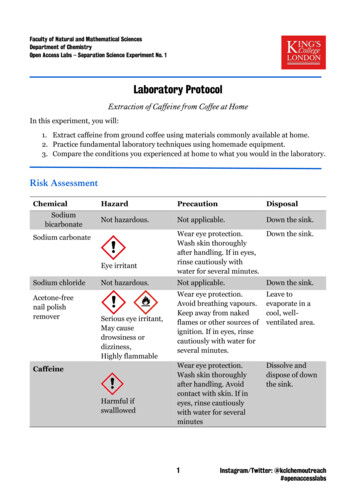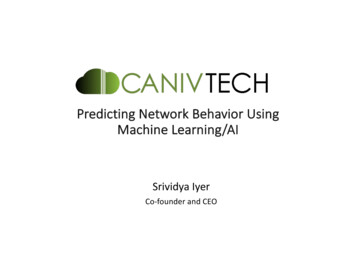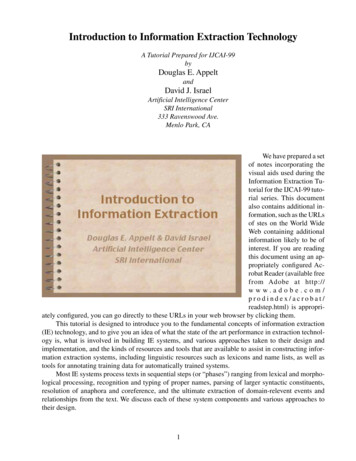
Transcription
Introduction to Information Extraction TechnologyA Tutorial Prepared for IJCAI-99byDouglas E. AppeltandDavid J. IsraelArtificial Intelligence CenterSRI International333 Ravenswood Ave.Menlo Park, CAWe have prepared a setof notes incorporating thevisual aids used during theInformation Extraction Tutorial for the IJCAI-99 tutorial series. This documentalso contains additional information, such as the URLsof stes on the World WideWeb containing additionalinformation likely to be ofinterest. If you are readingthis document using an appropriately configured Acrobat Reader (available freefrom Adobe at http://w w w. a d o b e . c o m /prodindex/acrobat/readstep.html) is appropriately configured, you can go directly to these URLs in your web browser by clicking them.This tutorial is designed to introduce you to the fundamental concepts of information extraction(IE) technology, and to give you an idea of what the state of the art performance in extraction technology is, what is involved in building IE systems, and various approaches taken to their design andimplementation, and the kinds of resources and tools that are available to assist in constructing information extraction systems, including linguistic resources such as lexicons and name lists, as well astools for annotating training data for automatically trained systems.Most IE systems process texts in sequential steps (or “phases”) ranging from lexical and morphological processing, recognition and typing of proper names, parsing of larger syntactic constituents,resolution of anaphora and coreference, and the ultimate extraction of domain-relevent events andrelationships from the text. We discuss each of these system components and various approaches totheir design.1
In addition to these tutorial notes, the authors have prepared several other resources related toinformation extraction of which you may wish to avail yourself. We have created a web page for thistutorial at the URL mentioned in the Power Point slide in the next illustration. This page provides manylinks of interest to anyone wanting more information about the field of information extraction, including pointers to research sites, commercial sites, and system development tools.We felt that providing this resource would be appreciated by those taking the tutorial, however, wesubject ourselves to the risk that some interesting and relevant information has been inadvertentlyomitted during our preparations. Please do not interpret the presence or absence of a link to any systemor research paper to be a positive or negative evaluation of the system or any of its underlying research.Also, those who have access to a Power-PC based Macintosh system may be interested in the website devoted to the TextPro system, written by Doug Appelt. TextPro is a simple information extractionsystem that you can download and experiment with on your own. The system incorporates technologydeveloped under the recently concluded DARPA-sponsored TIPSTER program. The TIPSTER program provided much of the support for the recent development of IE technology, as well as the development of techniques for information retrieval over very large data collections. In addition to the basicsystem, the TextPro package includes a complete name recognizer for English Wall Street Journaltexts, and a finite-state grammar for English noun groups and verb groups. You can learn a lot aboutbuilding rule-based information extraction systems by examining these rules written in the CommonPattern Specification Language developed under the TIPSTER program, even if you do not have appropriate hardware to actually run the system.2
IntroductionLook at your directory; it is full of files.With a few exceptions, with extensions like“.gif” and “.jpeg,” they are text files of one kindor another. A text file is simply a data structureconsisting of alphanumeric and special characters. Your operating system, whatever it is, willhave a host of built-in commands for handlingsuch files. None of these commands need beespecially smart. In particular, none of themneed know anything about the lexical, syntacticor semantic-pragmatic structure of the language,if any, the files are in. Consider a “word count”program. It simply counts the number of sequences of characters that are separated by someconventional delimiter such as a SPACE. OrConsider UNIX grep: it searches a file for a string or regular expression matching an input string orpattern. The query string need not be a meaningful expression of any language; the same, of course, forany matches. If the query string is a meaningful expression of, say, English, that fact is quite irrelevantto grep.We speak of text processing only when the programs in question reflect, in some way or other,meaningful aspects of the language in which the texts are written. (We should note that InformationRetrieval, Information Extraction, Natural Language Understanding can all be applied to spoken language, that is to nontext, audio files; in this tutorial, however, we shall focus solely on Text Processingapplications.) The simplest IR programs simply perform a variant of grep. More advanced IR methods, on the other hand, take into account various aspects of morphology, phrasal structure, etc. Thus,with respect to morphology, a query searching for documents about “information extraction” mightmatch on texts containing various form of the root verbs “inform” and “extract.” In the IR world, this isknown as stemming. (For more on IR, visit http://www.cs.jhu.edu/ weiss/ir.html)One cannot draw a clear boundary separating Information Retrieval from Information Extractionin terms of the complexity of the language features embodied in the program. The same is true on the3
other side of this spectrum, dividing Information Extraction from (full) Text Understanding. The bestway to characterize the different methodologies is in terms of functionality—at least functionalityaimed at, if not achieved—and task requirement. The task of IR is to search and retrieve documents inresponse to queries for information. The fewer irrelevant documents retrieved, other things being equalthe better; the fewer relevant texts missed, the better. The functionality of Text Understanding systemscannot be so easily characterized; nor, correlatively, can the task requirements or criteria of success.What counts as (successfully) understanding a text?The case of Information Extraction is more like that of IR, at least with respect to having, or atleast allowing, fairly determinate task specifications and criteria of success. Though we should notethat, as with IR, interpersonal agreement on what counts as success is not necessarily easy to come by.The specification can be presented in two different forms: (i) something very like an IR query—a shortdescription of the kind of information being sought, or (ii) a database schema or template, specifyingthe output format. Here's an example of a query or narrative, taken from MUC-7:“A relevant article refers to a vehicle launch that is scheduled, in progress or has actually occurred and must minimally identify the payload, the date of the launch, whetherthe launch is civilian or military, the function of the mission and its status."What is (a) MUC? A MUC is either a Message Understanding Conference or a Message Understanding Competition. MUCs were instituted by DARPA in the late '80s in response to the opportuni-4
ties presented by the enormous quantities of on-line texts. In a very real sense, DARPA created thefield of Information Extraction, in part by focusing in on a certain kind of task.As sketched above, IE is not a stand-alone task that human analysts typically engage in. It is anabstraction from such tasks (note, for instance, that the task is usually specified in a way that eitherprecludes or discourages rich domain-specific inference) -- an abstraction intended to be achievablewithout human intervention.The experience of the MUCs has demonstrated that IE is a difficult task. We notedthat, unlike Text Understanding, IE allows forfairly precise metrics of success. The fieldadopted and adapted a version of standardsignal processing measures, keyed to countsof true and false positives and true and falsenegatives. The names of the two basic measures, however, have been changed to Precision and Recall. Interestingly enough, one ofthe first things to be discovered was how difficult the task is for human beings, even fortrained analysts. The natural way to measurethis difficulty is by measuring interannotatoragreement. For various aspects of the Information Extraction tasks, interannotator agreement has usually been in the 60-80% range. This gives some idea of how difficult a task it is. Another bit of evidence, of course, is how well the competing systems have done at MUCs. The state-of-the-art seems tohave plateaued at around 60% of human performance, even after fairly intensive efforts ranging from amonth to many person-months.It seems safe to conclude that variations in this number across variations in applications is a crudemeasure of the relative difficulty of the applications. This latter in turn is determined by (i) the natureof the texts (ii) the complexity and variety of the kinds of information sought and (iii) the appropriateness of the chosen output representation to the information requirements of the task. We should notethat not much is known in a systematic way aboutany of these factors. Still, there is a general consensus that the 60% figure represents a rough upper bound on the proportion of relevant information that"an average document" wears on its sleeve, that is the proportion that the creator(s) of the documentexpress in a fairly straightforward and explicit way, and that doesn't require either complex syntatcicprocessing or, more usually significant use of domain-specific knowledge assumed to be accessible tothe document's human readers.Whatever the source of the difficulty,there are questions to be asked about the 60%plateau. One, that we will not discuss here, iswhether and to what extent that number is anartefact of the fairly complex nature of thetarget output representation and of the correspondingly complex scoring algorithm developed for MUC. Another is whether there areuses for a 60% technology, assuming that automatic creation of data bases from texts isnot a likely candidate application for the foreseeable future---not at 60% accuracy. If one5
thinks of Information Retrieval in this light, perhaps the answer is, "Yes". Indeed, a number of experiments on using IE for IR have been and are being pursued. We shall return to these at the end of thetutorial.6
Building Information Extraction SystemsAt this point, we shall turn our attention to what is actually involved in building informationextraction systems. Before discussing in detail the basic parts of an IE system, we point out that thereare two basic approaches to the design of IE systems, which we label as the Knowledge EngineeringApproach and the Automatic Training Approach.The Knowledge Engineering Approach is characterized by the development of the grammarsused by a component of the IE system by a “knowledge engineer,” i.e. a person who is familiar with theIE system, and the formalism for expressing rules for that system, who then, either on his own, or inconsultation with an expert in the domain of application, writes rules for the IE system component thatmark or extract the sought-after information. Typically the knowledge engineer will have access to amoderate-size corpus of domain-relevant texts (a moderate-size corpus is all that a person could reasonably be expected to personally examine), and his or her own intuitions. The latter part is veryimportant. It is obviously the case that the skill of the knowledge engineer plays a large factor in thelevel of performance that will be achieved by the overall system.In addition to requiring skill and detailed knowledge of a particular IE system, the knowledgeengineering approach usually requires a lot of labor as well. Building a high performance system isusually an iterative process whereby a set of rules is written, the system is run over a training corpus oftexts, and the output is examined to see where the rules under- and overgenerate. The knowledgeengineer then makes appropriate modifications to the rules, and iterates the process.The Automatic Training Approach is quite different. Following this approach, it is not necessaryto have someone on hand with detailed knowledge of how the IE system works, or how to write rulesfor it. It is necessary only to have someone who knows enough about the domain and the task to take acorpus of texts, and annotate the texts appropriately for the information being extracted. Typically, theannotations would focus on one particular aspect of the system’s processing. For example, a name7
recognizer would be trained by annotating a corpus of texts with the domain-relevant proper names. Acoreference component would be trained with a corpus indicating the coreference equivalence classesfor each text.Once a suitable training corpus as been annotated, a training algorithm is run, resulting in information that a system can employ in analyzing novel texts. Another approach to obtaining training datais to interact with the user during the processing of a text. The user is allowed to indicate whether thesystem’s hypotheses about the text are correct, and if not, the system modifies its own rules to accommodate the new information.To a scientist, the automaticallytrained systems seem much moreappealing. When grounded on statistical methods they are backed upby a sound theory, one can preciselymeasure their effectiveness as afunction of the quantity of trainingdata, they hold out the promise ofrelative domain independence, anddon’t rely on any factors as imponderable as “the skill of a knowledgeengineer.”However, human expertise andintuition should not be shortchanged. Advocates of the knowledge engineering approach are eager to point out that higher performance can be achieved by handcrafted systems, particularly when training data is sparse.This can lead to a sterile debate among partisans of the two approaches over which is “superior.”Actually, each approach has its advantages and disadvantages, and each can be used to advantage inappropriate situations.As was pointed out, the knowledge engineering approach has the advantage that to date, the bestperforming systems for various information extraction tasks have been hand crafted. Although automatically trained systems have come close to performing at the level of the hand crafted systems in theMUC evaluations, the advantage of human ingenuity in anticipating patterns that have not been seen inthe corpus, and in constructing rules at just the right level of generality have given those systems asmall but significant advantage. Also, experience suggests that given a properly designed system, abright college undergraduate is capable of competently writing extraction rules with about a week oftraining, so “IE system expertise” is less of an obstacle than one might expect.However, the knowledge engineering approach does require a fairly arduous test-and-debug cycle,and it is dependent on having linguistic resources at hand, such as appropriate lexicons, as well assomeone with the time, inclination, and ability to write rules. If any of these factors are missing, thenthe knowledge engineering approach becomes problematic.The strengths and weaknesses of the automatic training approach are complementary to those ofthe knowledge engineering approach. Rather than focusing on producing rules, the automatic trainingapproach focuses on producing training data. Corpus statistics or rules are then derived automaticallyfrom the training data, and used to process novel data. As long as someone familiar with the domain isavailable to annotate texts, systems can be customized to a specific domain without intervention from8
any developers. Name recognitionis an ideal task for the automatictraining approach because it iseasy to find annotators to producelarge amounts of training data —almost everyone intuitively knowswhat a “company name” is.The disadvantages of the automatic training approach also revolve around the fact that it isbased on training data. Trainingdata may be in short supply, ordifficult and expensive to obtain.Sometimes one may wish to develop an extraction system for atopic for which there are few relevant examples in a training corpus. Such situations place a premium on the human intuition of a good rule designer. If the relations that are sought are complex ortechnical, annotators may be hard to find, and it may be difficult to produce enough annotated data fora good training corpus.Even for simple domains like proper names, there is always a vast area of borderline cases forwhich annotation guidelines must be developed. For example, when annotating company names, arenonprofit entities like universities or the Red Cross considered “companies?” There is no “right” answer to questions like that; the answers must be stipulated and clearly understood by all the annotators.This implies that considerable care must be taken to ensure that annotations are consistent among allannotators. Although evidence suggests that the quantity of data is more important than its quality, it isprobably impossible to achieve truly high performance (e.g. F 95 or better on name recognition) withinconsistent training data. This implies that it might be more expensive to collect high-quality trainingdata than one would initially suspect. In fact, for many domains, collecting training data can be just as,if not more expensive in terms of time and personnel, as writing rules can be.Another problem worthy of consideration is the impact of shifting specifications on the rule writing or training task. It is certainly not the case that specifications for extraction rules will be set inconcrete the moment they are thought up. Often, the end users will discover after some experience thatthey want the solution to a closely related, yet slightly different problem. Depending on exactly howthese specifications change, it can impact Knowledge Engineered and Automatically Trained systemsdifferently. Suppose a name recognizer is developed for upper and lower case text, and then the userdecides that it is important to process monocase texts. The automatically trained systems can accommodate this change with minimal effort. One need only map the training corpus to all upper case andrun the training algorithm again. A rule based system that relies heavily on case heuristics may have tobe rewritten from scratch. Now suppose that an initial specification for extracting location names statesthat names of political jurisdictions are the kind of locations that matter. Later it is decided that thenames of mountains, rivers, and lakes should also be recognized. The rule writer can accommodate thischange by producing a handful of additional rules and adding them to the rule base. The automaticallytrained system is faced with a potentially much more difficult task, namely reannotating all the existingtraining data to the new specifications (this may be millions of words) and then retraining.9
It is also worth pointing out that not every module of an IE system has to follow the same designparadigm. It is perfectly reasonable to produce a system with a rule-based name recognizer that learnsdomain rules, or with a statistical name recognizer that operates on hand-generated domain rules whendata is scarce. The considerations relevant to deciding which approach to use are summarized on theaccompanying slide.In general one should consider usinga knowledge engineered system when linguistic resources like lexicons are available,there is a skilled rule writer available, training data is sparse, or expensive to obtain, itis critical to obtain the last small incrementof performance, and the extraction specifications are likely to change slightly overtime. Automatically trained systems are bestdeployed in complementary situations,where resources other than raw text are unavailable, training data can be easily andcheaply obtained, task specifications arestable, and absolute maximum performanceis not critical.Approaches to building both automatically trained and knowledge engineered systems components are discussed in more detail in the tutorial.The Architecture of Information Extraction SystemsAlthough information extraction systems that are built for different tasks often differ from eachother in many ways, there are core elements that are shared by nearly every extraction system, regard10
less of whether it is designed according to the Knowledge Engineering or Automatic Training paradigm.The above illustration shows the four primary modules that every information extraction systemhas, namely a tokenizer, some sort of lexical and or morphological processing, some sort of syntacticanalysis, and some sort of domain-specific module that identifies the information being sought in thatparticular application. (Actually, some extraction systems like name taggers actually stop at the lexical/morphological stage, but we are considering systems targeting events and relationships here.)Depending on the requirements of a particular application, it is likely to be desirable to add additional modules to the bare-bones system illustrated above.11
Tokenization is a trivial problem for European languages, requiring only that one separatewhitespace characters from nonwhitespace characters. For most newspaper texts, punctuation reliablyindicates sentence boundaries. However, in processing some languages like Chinese or Japanese, it isnot evident from the orthography where the word boundaries are. Therefore extraction systems forthese languages must necessarily be complicated by a word segmentation module.In addition to normal morphological and lexical processing, some systems may choose to includevarious feature tagging modules to identify and categorize part of speech tags, word senses, or namesand other open-class lexical items.For many domains, a rudimentary syntactic analysis is sufficient to identify the likely predicateargument structure of the sentence and its main constituents, but in some cases additional parsing, oreven full parsing my be desirable.Although it is possible to design an information extraction system that does not resolve coreferences or merge partial results, in many cases it is possible to simplify the domain phase and increaseperformance by including modules for that purpose.In summary, the following factors will influence whether a system needs modules over and abovethe “bare-bones” system: Language of the text. Some languages will require morphological and word segmentation processingthat English does not require. Genre. Extracting information from speech transcripts requires different techniques than text. Forexample, one may need to locate sentence boundaries that are not explicitly present in the transcript.Texts with mixed-case letters simplify many problems and eliminate much ambiguity that plaguessingle-case text. Informal text may contain misspellings and ungrammatical constructs that requirespecial analysis that newspaper text in general does not need. Text properties. Very long texts may require IR techniques to identify the relevant sections forprocessing. Texts that contain images or tabular data require special handling. Task. Tasks like entity identification are relatively simple. If one wants to extract properties ofentities, then the text needs to be analyzed for fragments that express the property. If the task involves extracting events, then entire clauses may have to be analyzed together.12
In this tutorial we will discusshow these modules are constructed,however we will not spend muchtime discussing modules for whichthe specific application of information extraction has no particular bearing. For example, the application ofa part of speech tagger to a text in aninformation extraction system is nodifferent than the application of a partof speech tagger in any other application. Therefore, we encourage youto read other sources in the literatureto find out more about part of speechtaggers.In understanding the influencethat the general information extraction problem has on the design of IE systems, it helps to understandinformation extraction as “compromise natural language processing.” A number of demands are placedon information extraction systems in terms of the quantity and quality of the texts that are processed. Tomeet these demands, some compromises have to be made in how natural language processing is carriedout that are not necessary in other domains like, for example, database question answering.Typically, IE systems are required to process many thousands of texts in a short period of time.The compromise made to satisfy this constraint is the use of fast but simple finite-state methods. Processing large volumes of real-world texts implies the adoption of robust techniques that will yieldacceptable performance even in the face of spelling and grammar errors. Also, the problems to whichIE systems are typically applied would typically require a great deal of domain-specific world knowledge to handle properly with a general natural-language processing system. The IE compromise is tobuild extraction systems that are very highly dependent on their particular domain of application. Although the core of an extraction system contains some domain independent components, domaindependent modules are the rule. This domain dependence arises through the incorporation of domainspecific extraction rules, or the training of the system on a corpus of domain-relevant texts.The Components of an Information Extraction SystemMorphological AnalysisMany information extraction systems forlanguages with simple inflectional morphology, like English, do not have a morphological analysis component at all. In English, it iseasy to simply list all inflectional variants ofa word explicitly in the lexicon, and this is infact how the TextPro system mentioned earlier works. For languages like French, withmore complex inflectional morphology, amorphological analysis component makesmore sense, but for a language like German,where compound nominals are agglutinated13
into a single word, morphological analysis is essential.Lexical LookupThe next task that is usually performed in the lexical/morphologicalcomponent of an extraction systemis lexical lookup. This raises thequestion of precisely what the lexicon should include. Since information extraction systems must dealwith highly unconstrained real-worldtext, there is a great deal of temptation to try to cover as much of thelanguage as possible in the system’slexicon. In addition, the specific domain of application is likely to introduce a sublanguage of terms relevantto that particular domain. The question arises about whether one shouldtry to broaden the lexicon so that itcovers almost any likely domain-specific sublanguage, or augment the lexicon with domain-specificentries for each application.It is somewhat paradoxical that bigger does not necessarily imply better when lexicons are considered. The larger the lexicon, the more likely it is to contain rare senses of common words. My favoriteexample is the word “has been” as a noun in the COMLEX lexicon. The problem is, that unless somerare sense is an important part of a domain-relevant sublanguage, the presence of these rare senses inthe lexicon will at best complicate parsing, and at worst create a space of possibilities in which incorrect analyses of common phrases are likely to be found and selected. We have had the actual experienceof updating an extraction system by doing nothing more than adding a bigger, more comprehensivelexicon. The bottom line performance of the system actually declined after the “improvement.”The general lesson to draw from this experiment is to beware the large list. Large lists of anything,including person names, locations, or just a large lexicon of ordinary words, tend to have unintendedconsequences caused by the introduction of unexpected ambiguity. In many cases, augmenting a lexicon or word list with a small quantityof domain-specific information is better than using a large superset of therequired vocabulary just because it isavailable. If large lists are employed, itis almost always necessary to devise astrategy for dealing with the ambiguity introduced thereby.Part of Speech TaggingAs mentioned earlier, some extraction systems do various kinds oftagging, including part of speech tagging, to make subsequent analysiseasier. It might be conjectured that part14
of speech tagging would be a good wayto deal with rare word senses, and the spurious ambiguity that can be introduced bylarge name lists.Part of speech tagging is certainlyuseful toward that end, however, if the onlyreason one does part of speech tagging isto avoid incorrect analyses caused by rareword senses, there may be easier and fasterways to accomplish the same ends.Even the best part of speech taggers,whether rule based or statistically based,are correct about 95% of the time. Thismay sound impressive, but it turns out thatmany of the cases where the informationprovided by a tagger would be most useful are precisely the cases in which the tagger is most likely to make errors. This eventuality has to bebalanced against the fact that part of speech tagging does not come for free. It takes some time to do,and some effort to train, particularly if the texts to be processed by the system are from a highlydomain-specific sublanguage, like military messages, for which taggers trained on normal data are lessaccurate.If what one is primarily interested in is the elimination of rare word senses, it may make moresense to use simple frequenc
Introduction to Information Extraction Technology A Tutorial Prepared for IJCAI-99 by Douglas E. Appelt and David J. Israel Artificial Intelligence Center SRI International 333 Ravenswood Ave. Menlo Park, CA We have prepared a set of notes incorporating the visual aids used during the Information

